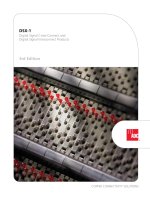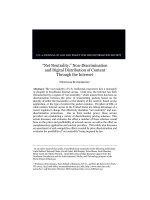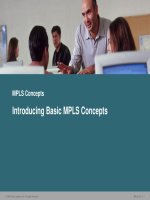Computers and digital basic computer concepts 2014 chapter02
Bạn đang xem bản rút gọn của tài liệu. Xem và tải ngay bản đầy đủ của tài liệu tại đây (4.2 MB, 70 trang )
Chapter 2
Computer Hardware
Computer Concepts 2014
2 Chapter Contents
Section A: Personal Computer Basics
Section B: Microprocessors and Memory
Section C: Storage Devices
Section D: Input and Output Devices
Section E: Hardware Security
Chapter 2: Computer Hardware
2
2 FastPoll True/False Questions
Answer A for True and B for False
020100 An all-in-one is a type of desktop computer.
020200 Small business computers have better sound
and graphics capabilities than home or game
computers.
020300 PCs, Macs, and Linux are three computer
platforms.
020400 Today’s Macs can be configured to run
Windows.
020500 Pentium, Core, ARM7, and Athlon are types of
microprocessors.
Chapter 2: Computer Hardware
3
2 FastPoll True/False Questions
Answer A for True and B for False
020600 Today’s computers typically process 8 bits
at a time.
020700 Serial processing is when a processor
begins executing one instruction before it completes
the previous instruction.
020800 In RAM microscopic electronic parts called
capacitors hold the bits that represent data.
020900 ROM is a type of memory that holds the
computer’s startup routine.
Chapter 2: Computer Hardware
4
2 FastPoll True/False Questions
Answer A for True and B for False
021000 Hard disk drives, optical drives, and solid
state drives are random access devices.
021100 CD-RWs allow you to record data, but data
cannot be changed once it is recorded.
021200 1080p is a measure of resolution.
021300 A surge strip allows you to use your desktop
computer during a power outage.
Chapter 2: Computer Hardware
5
Section
A:
Personal
2
Computer Basics
Desktop Computer Systems
Portable Computers
Buying a Computer
Home, Game, and Small Business Systems
Chapter 2: Computer Hardware
6
2 Question
022100 In the interest of being ecological, many consumers
consider upgrading their computers instead of disposing of
them and buying a new one. Which one of the following
upgrades is best left to professional technicians?
A. Replacing the microprocessor with a newer model
B. Adding an external hard drive for backup
C. Swapping out a graphics card for a more powerful one
D. Adding RAM
Chapter 2: Computer Hardware
7
2 Desktop Computer Systems
A desktop computer fits on a desk and runs on
power from an electrical wall outlet
The main component of a typical desktop computer
is a system unit that houses the processor, memory,
storage devices, display circuitry, and sound
circuitry
The term peripheral device designates input,
output, and storage equipment that might be added
to a computer system to enhance its functionality
Chapter 2: Computer Hardware
8
2 Desktop Computer Systems
Chapter 2: Computer Hardware
9
2 Desktop Computer Systems
A typical desktop computer system includes several
components
System unit
Keyboard
Mouse
Hard disk drive
Optical drive
Removable storage
Sound system
Display system
Network and Internet access
Printer
Chapter 2: Computer Hardware
10
2 Desktop Computer Systems
In the computer industry, the term form factor refers
to the size and dimensions of a component, such as
a system board or system unit
Chapter 2: Computer Hardware
11
2 Portable Computers
A portable computer is a small, lightweight personal
computer
Portable computer form factors include clamshell styles and
slate styles
A laptop computer (also referred to as a notebook computer)
is a small, lightweight portable computer that opens like a
clamshell to reveal a screen and keyboard
Chapter 2: Computer Hardware
12
2 Portable Computers
Chapter 2: Computer Hardware
13
2 Portable Computers
Three types of computers are available in the slate form factor:
enhanced media players, smartphones, and tablets
An enhanced media player is a handheld device designed for playing
music and videos, and offers a camera, access to the Internet, and a
variety of apps
A smartphone is an enhanced mobile phone that typically also functions
as a portable media player and has the capability to access the Internet
A tablet computer is a handheld computer that is essentially a large
version of an enhanced media player
Chapter 2: Computer Hardware
14
2 Portable Computers
Chapter 2: Computer Hardware
15
2 Buying a Computer
Browse through computer magazines and online computer
stores to get a general idea of features and prices
Decide on a budget and stick to it
Make a list of the ways you plan to use your computer
Select a platform
Decide on a form factor
Select peripherals, software, and accessories
Chapter 2: Computer Hardware
16
2 Buying a Computer
Chapter 2: Computer Hardware
17
2
Home, Game, and
Small Business Systems
Today, the term home computer system encompasses a vast
array of computer configurations designed to accommodate
consumers who use computers for personal tasks
Some of the most cutting-edge computers are designed for
gaming
Computers marketed for small business applications tend to
be middle-of-the-line models pared down to essentials
Chapter 2: Computer Hardware
18
Section
B:
Microprocessors
2
and Memory
Microprocessor Basics
Today’s Microprocessors
Random Access Memory
ROM and EEPROM
Chapter 2: Computer Hardware
19
2 Question
022200 Some computers are suitable for e-mail, word
processing, and similar low-key operations, whereas other
computers have the power to keep up while you play
complex action games, edit high-resolution videos, and
prepare multi-track sound recordings. Which of the following
computers is the most powerful?
A. Intel Core 7 quad-core processor; 48 GB RAM
B. AMD Phenom Quad core processor; 4 GB RAM
C. Intel Core 2 Quad processor; 2 GB RAM
D. ARM7processor; 4 GB RAM
Chapter 2: Computer Hardware
20
2 Microprocessor Basics
A microprocessor is an integrated circuit designed to process
instructions
Usually the most
expensive component
of a computer
Chapter 2: Computer Hardware
21
2 Microprocessor Basics
Microprocessor clock
Gigahertz
Multicore processor
Front side bus
CPU Cache
Level 1 cache (L1)
Level 2 cache (L2)
Level 3 cache (L3)
Word size
Chapter 2: Computer Hardware
22
2 Microprocessor Basics
CISC vs. RISC technology
Serial processing
Pipelining
Parallel processing
Benchmarks
Chapter 2: Computer Hardware
23
2 Today’s Microprocessors
Chapter 2: Computer Hardware
24
2 Random Access Memory
RAM (random access memory) is a temporary holding area
for data, application program instructions, and the operating
system
Chapter 2: Computer Hardware
25









